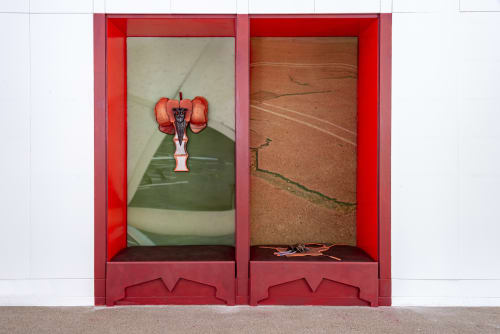Alia Hamaoui is a British-Lebanese artist living and working in London. Her multidisciplinary practice explores the proximate relationship of humanity and heritage and aims to advance our understanding of the interrelationship between cultural identity, the object and place, as viewed from within our increasingly tech-infused existence. She is particularly interested in specific cultural artefacts that have been utilised by the cultural industry in shaping broader narratives of regional or national identity.
Hamaoui’s sculptures often feature upholstered, padded forms made from terracotta-toned fabrics, which hang alongside pewter renditions of ancient Phoenician weapons. Her work merges clear references to archaic archaeology with elements of clothing and attire, employing textures and materials that evoke a deep sense of intimacy. The denim shorts hugging thighs and shin pads suggest an invitation to tackle, reflecting ideas about how the past literally encases the body. Hamaoui explores how fabrics, textiles, and clothing often express the female perspective of entrapment, especially within the gothic tradition.
In her predominately sculptural process, Hamaoui layers, merges, and hybridizes objects, wrapping one within another, rendering these otherwise functional objects obsolete. This suggests a different form of activation, perhaps alluding to the gothic concept of ‘doubling’ or the Islamic superstition of the djinn named Qareen. Throughout her work, she pairs and mirrors objects, creating sculptural arrangements that evoke circularity and the repetition of the returning past.
For her installation in Palmer Gallery’s fourth exhibition Between Hands and Metal, Hamaoui situates these unwearable costumes within what she considers a contemporary ruin - a space reminiscent of a sports changing room, specifically a ‘gothicised’ version of the Chamoun Sports Stadium in South Beirut. This stadium, once a vibrant part of Lebanon’s nationalistic project as the host of the Pan Arab Games and the Jeux de la Francophonie, now sits half-occupied, serving as a replacement wheat silo and army barracks. The history of this space mirrors that of modern-day Lebanon, embodying both the vibrancy and decay of the nation’s past and present.
